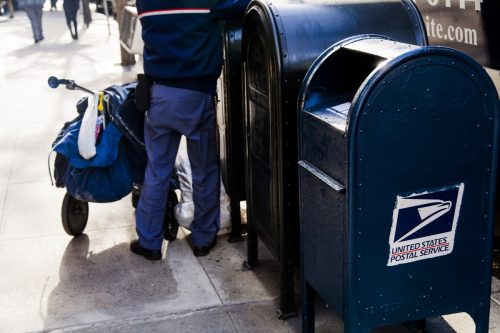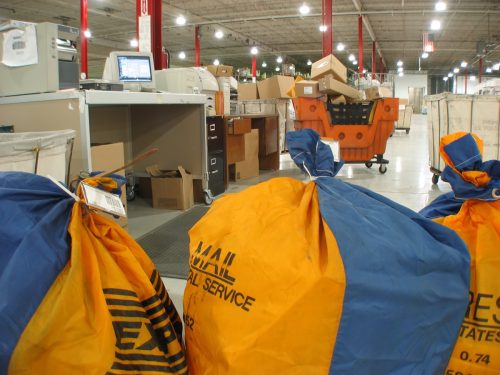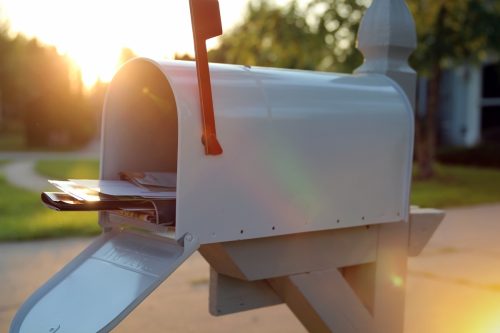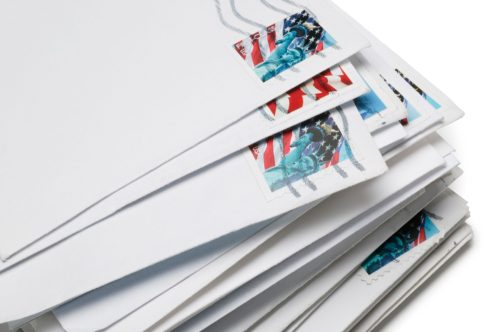Never Mail This in a Letter, USPS Worker Warns
Your mail could end up destroyed before it's able to be delivered.

Most of us have come to rely on the U.S. Postal Service (USPS) for two basic things: they deliver the mail we get sent to us and they deliver the mail we send to others. But it's not always that simple. The USPS has previously warned customers that there are a number of reasons why they might stop receiving their mail—like having a loose dog in the neighborhood (5,400 postal employee were attacked by dogs in the U.S. in 2021 alone). But now, a postal worker is warning customers that what they put in a letter could prevent their mail from making it through the system. Read on to find out what one USPS employee says you should never mail in a letter.
READ THIS NEXT: If You Get This in the Mail, Call the Authorities, Police Warn.
The USPS has already warned Americans about changes to their mail.

Over the past several months, the USPS has already shared several warnings about future changes set to be made to your delivery service. In July, Americans will experience a price-hike for their First-Class Mail, as the USPS filed notice with the Postal Regulatory Commission (PRC) on April 6, announcing that it would be raising First-Class Mail prices by 6.5 percent. Then in August, the agency is actually planning to speed up its deliveries for some customers shipping USPS Retail Ground (RG) and Parcel Select Ground (PSG) packages by shifting service standards from two to eight days to two to five days.
But while the Postal Service is making overall structural changes to your mail service, some workers are sending out warnings to customers on a local level about issues they might already be facing with their deliveries—and how they can fix the problem themselves.
A postal worker is making a direct plea to customers.

A Postal Service worker recently took to TikTok to share a warning with customers about what they shouldn't be mailing inside the letters they send. According to the employee, who posted anonymously through an account called "SecretsofUSPS," certain items can't go into the machines used to sort letters sent through the postal system.
"Stop sending coins, cards, keys, and jewelry through letters. This machine will rip them out," the employee wrote on top a video of a running Delivery Barcode Sorter (DBCS) in March. The employee later clarified in a comment, "When I say cards, I mean collective cards. They're usually in protective plastic sleeves. And those don't stand a chance against these machines."
RELATED: For more up-to-date information, sign up for our daily newsletter.
Employees say that these machines process thousands of letters in an hour.

A DBCS machine automatically sorts letter-sized mail that is barcoded, per the USPS. According to Newsweek, each machine can sort around 36,000 letters in an hour and only two workers usually work alongside them—one who inputs the mail and another who gathers it after it's sorted. But putting through letters that have items like coins, cards, keys, and jewelry in it can halt this process entirely. "I can't even count how often [the machine] jams due to stuff like that," the worker captioned their TikTok video.
Another USPS worker replied to the video, adding that they work on the machines and recently had to fix a DBCS that was stuck due to items that were mailed a letter. "Literally pulled out a jam yesterday that was a Ziploc bag full of screws in an envelope," they said.
Your mail might not end up making it to its intended destination if you disregard this advice.

One USPS employee commented on the video and said at their post office location, workers have just started checking through the mail because so many letters end up ripped apart by DBCS machines and take out the ones that have items that cannot go through. But not every facility is going to take the extra time to do that—and as a result, your items might not make it to their intended destination. "There's a huge chance you'll receive an empty envelope," the USPS worker added in the caption of the original video on the SecretsofUSPS account.
Another post office worker who said they also "service these machines" confirmed that items are often found separated from their original envelopes later on. "Can definitely confirm that at the end of each night I find coins, keys and pens," they commented on the video. But that might not even be the worst part. Sometimes your entire letter might end up not making it to its intended destination. "What's worse is that the original letter where it came was most likely destroyed because of it. Now we have no clue where to forward it," the post office mechanic added in their comment.
But you can pay an extra fee to avoid having your letter go through this kind of machine.

While some postal locations reportedly sort letters by hand already as a precaution, there is another way to ensure your letter doesn't go through a DBCS machine—which might be important if you are mailing items in it that could get caught. A USPS worker told Newsweek that customers can buy a non-machinable stamp so that their letters gets treated as a parcel and are hand-processed rather than put through a DBCS.
"The post office has already figured out a way to accommodate small rigid items. For only 30 cents more, you can use a non-machinable stamp," the employee explained. "This will let the clerks know to hand sort your letter."
The USPS confirms this on its website as well. "A non-machinable mailpiece is sorted outside of the standard automated mail process. A surcharge applies because it is more expensive to processes," the agency explains.





















